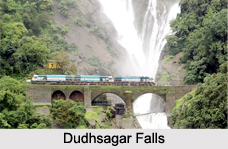 Dudhsagar Falls is one of the picturesque waterfalls located on the border of Goa and Karnataka. It is listed as India`s 5th tallest waterfall, and is 227th in the world. This waterfall is a major part of the ecological system of Goa. It is a four tiered waterfall that falls from a height of 310 m and an average width of 30 metres. Dudhsagar Falls attracts a steady stream of visitors from varied distant places of the country.
Dudhsagar Falls is one of the picturesque waterfalls located on the border of Goa and Karnataka. It is listed as India`s 5th tallest waterfall, and is 227th in the world. This waterfall is a major part of the ecological system of Goa. It is a four tiered waterfall that falls from a height of 310 m and an average width of 30 metres. Dudhsagar Falls attracts a steady stream of visitors from varied distant places of the country.
Etymology of Dudhsagar Falls
Dudhsagar Falls means the `Sea of Milk`. The name is derived from the clouds of milky foam which rises up at the bottom of the falls. It is a Konkani name.
Location of Dudhsagar Falls
Dudhsagar Falls is located on the Mandovi River in Goa and is around 60 km from Panaji by road. It is also located on the Madgaon-Belgaum rail route about 46 km south of Madgaon and 60 km north of Belgaum. It is around 10 kilometres from Kulem Railway Station.
History of Dudhsagar Falls
The mythological history of Dudhsagar Falls is associated with the local princess. There was a powerful and wealthy king who ruled a kingdom in the Western Ghats Mountain Range in India. In the hills, his palace was enveloped by vast gardens. The king had a beautiful daughter. She loved to bath in the scenic lake near the forest on the edge of the King`s palace grounds. She had a unique habit. After her bath, she always had a jugful of sugared milk in a jug made of pure gold. One day, as she was following her routine, she noticed a handsome prince watching her by standing amongst the trees. Out of embarrassment, the princes poured the sugared milk in front of her to form an improvised curtain to hide her body. This incident led to the birth of Dudhsagar Falls. The sugared milk poured down the mountainside and continued to flow in torrents as a mark of respect to the modesty of the Princess.
Geography of Dudhsagar Falls
Dudhsagar Falls is located in the Bhagwan Mahaveer Sanctuary and Mollem National Park among the Western Ghats Mountain Range in India. Dudhsagar Falls forms the border between Karnataka and Goa states. The area is surrounded by deciduous forests with rich bio diversity. Dudhsagar Falls are not particularly spectacular during the dry season but during the monsoon season however, the falls are fed by rains and form a huge force of water.
Attraction of Dudhsagar Falls
Dudhsagar Falls is set amidst mesmerising scenery overlooking a crescent-shaped head of a valley carpeted with pristine tropical forest which is home to monkeys, birds, bees, and butterflies. However, it is not spectacular during the dry season. At the time of monsoon season, Dudhsagar Falls become one of the most powerful falls in India.
Dudhsagar Falls as a Trekker"s Spot
Dudhsagar Falls is a paradise for the trekkers and hikers. The trekkers can visit it in September and during the monsoons when it is in full and furious flow. There are also some pools in the vicinity which offer swimming facilities to the visitors. People can also visit the Tamdi Surla Temple located in the neighbouring area. The temple was built by the Kadambas. Thus, it`s a great place for a day full of fun and frolic.
Visiting Information
The nearest rail station accessible by road to Dudhsagar Falls is Castle Rock Station. The visitors could get in a train from here and disembark at the Dudhsagar stop. It is to be noted that the Dudhsagar rail stop is not a station where passengers can expect a platform. Passengers and visitors have to climb down the steep ladder of the rail compartment in a short 1-2 minute unscheduled stop. From this rail stop, visitors have to walk about a kilometre on the tracks to arrive at the falls. While the walk itself is something unexpected for a popular tourist destination, there is a 200 meters train tunnel that is totally dark which makes the walk a bit tougher. It can be reached also by trekking by walking from the Dudhsagar Railhead, which is 1 kilometre walk.
Related Articles
Tourism In Karnataka
Waterfalls in Karnataka
Geography of Karnataka
Temples of Karnataka
Western Ghats Mountain Range in India
Eastern Ghats Mountain Range in India
South Western Ghats Montane Rain Forests in India
Sahyadris Mountain Range






